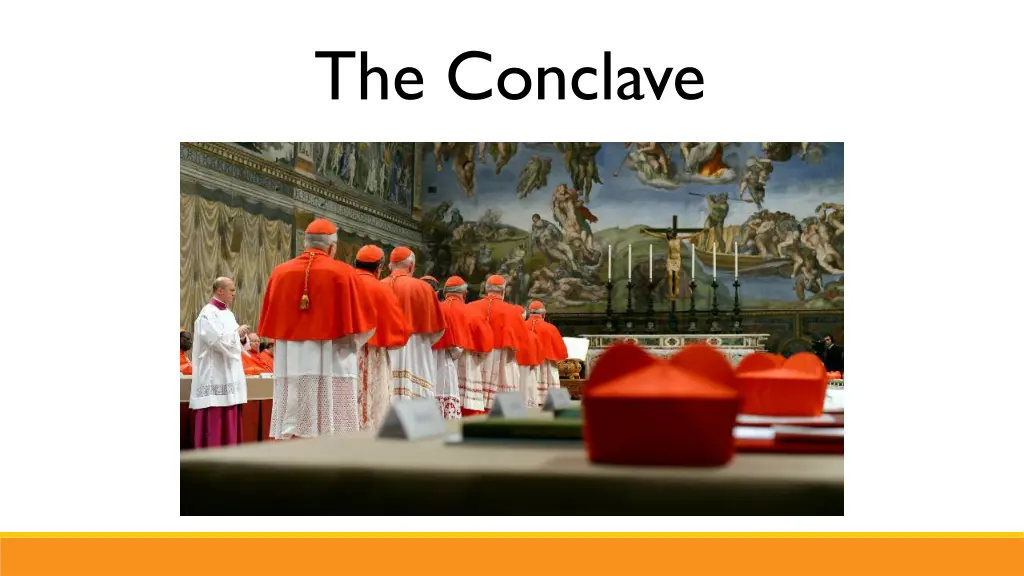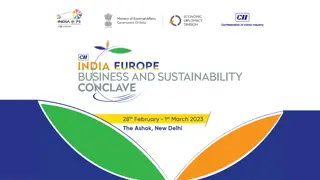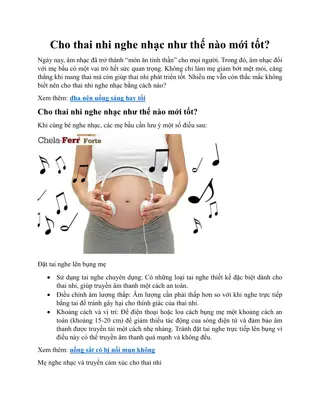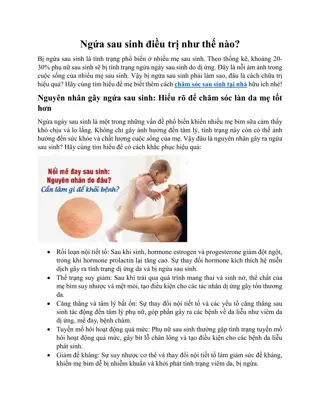
Cardinals and the Papal Conclave: Insights into the Election Process
Learn about the upcoming papal conclave where cardinals will elect a new pope. Discover the history of papal elections, the number of eligible voters, the preparation process, and the origin of the term "conclave." Join us for a detailed exploration of the sacred tradition of selecting the Bishop of Rome.
Download Presentation

Please find below an Image/Link to download the presentation.
The content on the website is provided AS IS for your information and personal use only. It may not be sold, licensed, or shared on other websites without obtaining consent from the author. If you encounter any issues during the download, it is possible that the publisher has removed the file from their server.
You are allowed to download the files provided on this website for personal or commercial use, subject to the condition that they are used lawfully. All files are the property of their respective owners.
The content on the website is provided AS IS for your information and personal use only. It may not be sold, licensed, or shared on other websites without obtaining consent from the author.
E N D
Presentation Transcript
On Wednesday 7 May the cardinals of the Catholic Church will meet to elect a new pope. Among them will be three cardinals from England.
Cardinal Arthur Roche, Prefect of the Dicastery for Divine Worship and the Discipline of the Sacraments Cardinal Vincent Nichols, Archbishop of Westminster Cardinal Timothy Radcliffe, Dominican priest
Who elects a pope? One of the titles of the pope is Bishop of Rome . In the early church, the people and clergy of Rome elected the Bishop of Rome or pope. Over time, this was refined to the clergy, and further reduced to be just the parish priests of Rome. Whenever a cardinal is created, he is appointed as the titular parish priest of a parish in Rome, even though he may live in another country and so the tradition continues.
How many cardinals are there? There are currently 252 cardinals but only those who are under 80 years old are eligible to vote. That leaves 135 cardinals who will be able to vote.
How do they prepare to vote? All of the 252 cardinals were invited to a series of meetings which began the day after Pope Francis died. They have been sharing their experiences about the Church in their part of the world so that they can discern the needs of the worldwide Church. Any of them can speak, whether they will be able to vote or not. Many of them may not have met before so this is a valuable time for them to get to know one another. They will also be dining together and having conversations in smaller groups.
Why is it called a conclave? In 1271 the process to elect a pope had already lasted over two years and nine months. The people got tired of waiting and eventually locked them in with a key in Latin, con clave and would not let them out until they had elected a pope. The tradition continues to this day, although they no longer lock the doors.
Who elects a pope? While the conclave is in process, the cardinals stay in a separate building at night and meet in the Sistine Chapel by day. They are forbidden from communicating with the outside world by any means. They are not allowed to watch television, access the internet, make calls or send messages, to ensure that they are not biased in their voting by any outside influences. Before the conclave begins, the Sistine Chapel is searched thoroughly for bugs and other devices which might have been planted there.
How do they vote? Voting begins on the first day, when one ballot is held in the afternoon if possible. If the first ballot does not produce a result, there are two ballots each morning and each afternoon until a result is declared. Cardinals may vote for anyone who they feel to be the right choice to lead the Catholic Church. Technically the person they choose does not have to be a cardinal or even a priest, simply a male baptised Catholic, but in practice it will be one of the cardinals.
How do they vote? On the voting slip, each cardinal writes the name of the person he wishes to vote for, trying to disguise his writing as much as possible. He then swears before all present that the vote is for the person of his choice and places the vote onto a silver plate before then putting it into the chalice on the altar.
The results Once everyone has voted, the names are read out. The names are counted and if one name has received two thirds of the votes, the pope has been elected. If not, the process is repeated for three days only. After three days of unsuccessful voting, the procedure is suspended for a day to give time for prayer, reflection and informal discussions. They then continue for a further three days.
How will we know when a pope has been elected? After each ballot, the papers are burned and the smoke goes up through a chimney where it can be seen by the people waiting in St Peter s Square. If the vote has been unsuccessful, the papers are burned with a cartridge producing black smoke. If it has been successful, a cartridge is added to make the smoke white. Since in the past, there has been some confusion over whether a pope has been elected or not, the bells will be rung when a pope has been elected.
How is the conclave different to other elections? The whole process of the election takes place in an atmosphere of prayer and reflection. Every day begins with Mass and the cardinals mark particular hours of the day in prayer together. Some are chosen to lead spiritual reflections during the process. The cardinals are seeking the will of God through the direction of the Holy Spirit. Each of them will be praying for the gifts of the Holy Spirit, in particular for wisdom and understanding, to help him vote for the successor of Saint Peter.
A secret process Even after the process is over, the cardinals cannot reveal any information about the voting or about matters discussed concerning the election of the pope. The results of all votes are given to the newly elected pope to be stored in the Vatican archives.
What happens next? The successful candidate is then asked if he accepts his election (which he can refuse). He is then asked what name he will choose as pope. The cardinals then pledge their obedience to His Holiness in turn. The pope puts on special clothes (a white soutane and skull cap) - the Italian family business in Rome that makes all the papal vestments has several different sizes prepared in readiness for His Holiness.
The pope is presented to the world The Cardinal Deacon announces the result of the election to the people in St Peter's Square. The new pope then comes out and gives his blessing.
Let us pray Lord God, hear our prayers for the cardinals entrusted with electing a successor to the Apostle Peter. May they be filled with the gifts of the Holy Spirit as they discern the needs of the Church in this age. May they choose a worthy shepherd to lead us and guide us. We make this prayer through Christ our Lord. Amen.






















